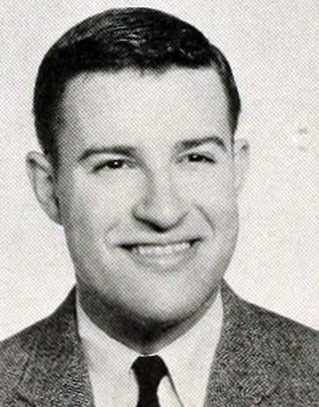
A native of New York, Mike Katsias was one of East Carolina’s most active and well-rounded undergraduate. A double-major in social studies and English, Katsias was a member of Alpha Phi Omega, a service fraternity, and Lambda Chi Alpha, one of East Carolina’s earliest social fraternities. He was also on the staff of the Buccaneer and the East Carolinian, and a member of the ECC tennis team, the YMCA, the Young Democrats Club, the Canterbury Club, the Inter-Fraternity Council, the Student Legislature, the Senate, the College Union Student Board, and the National Student Congress. Katsias also participated in the East Carolina Playhouse. His senior year, he was included in the Who’s Who Among Students in American Universities and Colleges. Following graduation, Katsias earned a master’s degree at ECC, and then later became a successful realtor and community leader in Virginia Beach. Following his passing in 2001, the Virginia General Assembly passed a resolution honoring his legacy in business, education, religion, and philanthropy.
As SGA president, Katsias oversaw a controversial transformation of ECC’s student government away from the student legislature that had existed since the early 1940s, including the presidents of all campus organizations, and to the creation of a more representative body, the “Senate.” In the process, work was initiated on drafting a new and more streamlined constitution for the SGA meant to replace the hodgepodge document dating from the spring of 1943 when the Student Cooperative Government Association (SCGA) was formed combining the previous Men’s Student Government Association and the Women’s Student Government Association. Under the SCGA, a Student Cooperative Council – after 1949, called the Student Legislature – composed of class representatives, presidents of student clubs and organizations, editors of student publications, and the vice-chairmen of the Men’s and Women’s Judiciaries. With the new 1959 SGA constitution, the unified student government became more representative and democratic, especially through the newly created Senate, populated by elected legislators serving in it specifically in that capacity.
In the late-1950s, Katsias was one of East Carolina’s most perceptive and far-sighted students. In an article published in the East Carolinian on October 29, 1959, following his year as president of the SGA, Katsias noted how the campus had become more politically active than ever. He noted, presumably thinking of state senator, Robert Morgan (1925-2016), how ECC alumni were “assuming important positions in state politics.” Aware of then Vice President Leo W. Jenkins’ interest in politics, Katsias noted that “It would not be surprising to see an East Carolina man emerge as the recipient of an important state position as a result of his efforts in the coming campaign [in 1960] for the winning side.” Cognizant of the phenomenal growth East Carolina was undergoing, Katsias predicted that “by 1965, the school could easily reach an enrollment of 7,500 students. University status is another serious consideration to place on the agenda for the near future (italics added).” The same issue of the East Carolinian announced the resignation of John D. Messick as president of the school. While that news shook the campus and the community, Katsias perhaps realized that the Jenkins’ era ahead would bring momentous changes for East Carolina.
On another count, however, Katsias seemed less prescient. During his year as SGA president, the Cavaliers became “the first Negro entertainers on campus.” That followed the ECC Board of Trustees’ decision to allow black performers, which in turn followed a Dave Brubeck Concert wherein a black musician appeared, to the surprise of students, administrators, and trustees, as a substitute for an ill-band member. With these developments, the beginnings of East Carolina’s compliance with the 1954 Brown v. Board of Education decision, disallowing “separate but equal” public educational facilities, became a reality. Despite his contributions to student progress and ready involvement in campus life, Katsias, a New Yorker by birth, remained silent on the matter, even as it appeared, occasionally and often problematically, in the pages of the East Carolinian. Katsias, like the vast majority of East Carolina students during the late-1950s, seemed oblivious to the social changes and challenges facing the school.
Sources
- “’58-’59 This Was The Year When…” East Carolinian. Vol. 34, no. 25. May 14, 1959. P. 3. https://digital.lib.ecu.edu/38631
- “Alpha Phi Omega.” Buccaneer. 1959. P. 276. https://digital.lib.ecu.edu/15310
- Arnold, Billy. “Katsias Overrules Bitter Opposition To Budget.” East Carolinian. Vol. 34, no. 1. September 25, 1958. P. 1. https://digital.lib.ecu.edu/38607
- Eagles, Rosemary. “Katsias Answers Top Questions.” East Carolinian. Vol. 33, No. 25. May 8, 1958. P. 1. https://digital.lib.ecu.edu/38602
- Eagles, Rosemary. “Mike Katsias Files As First SGA Presidency Candidate.” East Carolinian. Vol. 33, no. 17. March 6, 1958. P. 1. https://digital.lib.ecu.edu/38594
- “Group Promises Dynamic Changes in Constitution.” East Carolinian. Vol. 34, no. 15. February 5, 1959. P. 1. https://digital.lib.ecu.edu/38621
- Katsias, Mike. “Politics Focus On Campus.” East Carolinian. Vol. 35, no. 7. October 29, 1959. P. 2. https://digital.lib.ecu.edu/38642
- Katsias, Mike. “Campus Overtones: Greek System Takes Big Step.” East Carolinian. Vol. 35, no. 5. October 15, 1959. P. 2. https://digital.lib.ecu.edu/38640
- “Katsias Receives 1326 Votes in Election.” East Carolinian. Vol. 33, no. 20. March 27, 1958. P. 1. https://digital.lib.ecu.edu/38597
- “Light Ballot Boxes Favor New Student Constitution.” East Carolinian. Vol. 34, no. 25. May 14, 1959. P. 1. https://digital.lib.ecu.edu/38631
- “Senate Joint Resolution No. 153: On the death of Michael Katsias.” http://lis.virginia.gov/cgi-bin/legp604.exe?021+ful+SJ153ER
- “Student Government Association.” Buccaneer, 1959. Pp. 218-224. https://digital.lib.ecu.edu/15310
More from Digital Collections

Citation Information
Title: Emanuel “Mike” Katsias
Author: John A. Tucker, PhD
Date of Publication: 6/19/2019